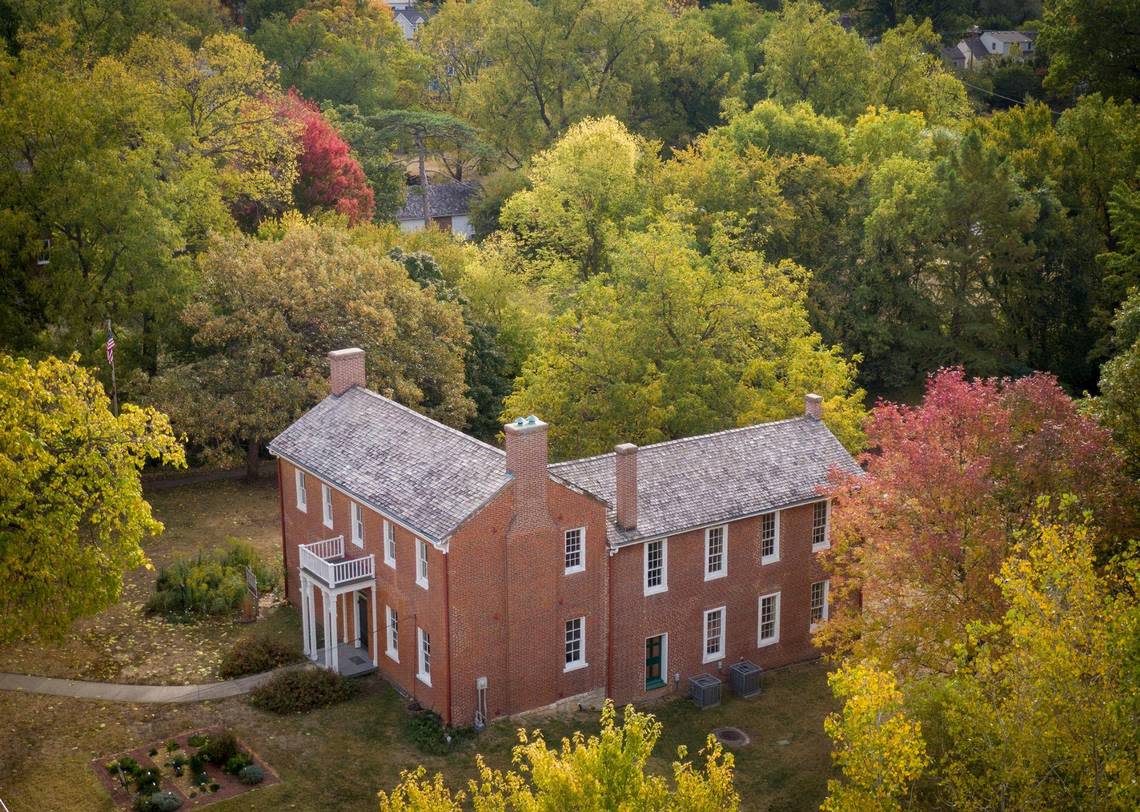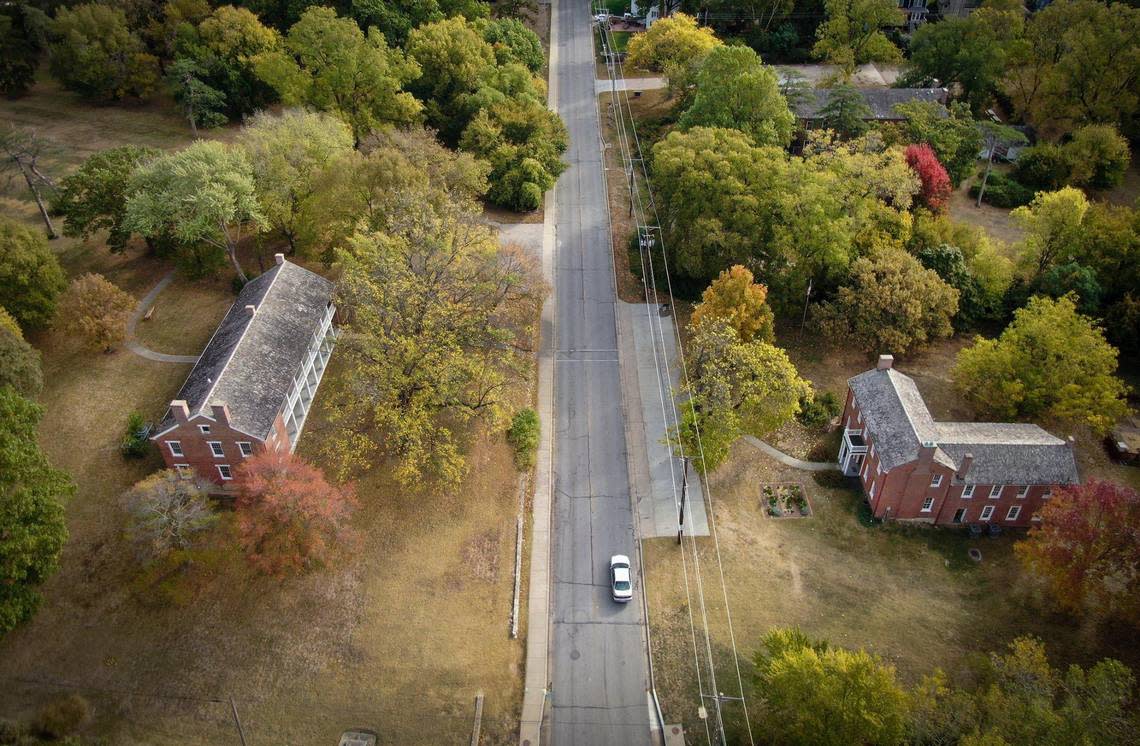Tribe wants to take over Shawnee Indian Mission, says buildings are in ‘deep distress’
A battle is brewing over ownership of the Shawnee Indian Mission in Johnson County, as the Shawnee Tribe lobbies to take over the state historic site, arguing that the former boarding school site has not been properly maintained and is in “deep distress.”
The three brick buildings at the Fairway site are deteriorating and need millions of dollars in restoration work, according to an architectural study the tribe released to The Star on Tuesday, days before the Kansas legislative session begins.
The tribe released the findings as it speaks with legislators about potentially conveying the property from the state of Kansas to the Shawnee Tribe. While several details remain unclear, some expect the tribe to lobby to have a bill introduced this session aiming to take ownership of the 12-acre site at 3403 W. 53rd St., off Mission Road.
“This report confirmed what we had always feared: the Shawnee Indian Manual Labor Boarding School is in deep distress and is an endangered site,” Shawnee Chief Ben Barnes said in a statement. “Over the last year, we have had numerous conversations with the city and state about the need to save this special place. When it became clear that there was no plan in place, we began conversations about the possibility of the Shawnee Tribe assuming responsibility for restoring and repairing this site.”
The Shawnee Tribe said that it commissioned the study from Architectural Resources Group last year because leaders are “concerned about the future of this historic site.”
“The school was originally opened in 1839 on Shawnee land, built by Shawnee hands, and remains an important site in the Tribe’s history. The Tribe has designated the site as Mission as a Sacred Site, which means the place is of significant cultural import that the Tribe seeks to protect from any acts of desecration.”
But officials with the Kansas Historical Society, which owns the site, said, “In general, the report contained no surprises, and the repair of many of the smaller issues noted” had either been made or were underway by the time the report was completed. Officials said that the Historical Society has made several other improvements and is planning for future restoration work.

Fairway and Kansas push back
It is the latest development in an increasingly sour relationship between the Shawnee Tribe and the state and city of Fairway, which manages the day-to-day operations of the property.
“Chief Barnes has communicated that his ultimate goal is to acquire the land of the Shawnee Indian Mission State Historic Site,” Fairway city officials said in an email Tuesday. “Chief Barnes has previously expressed that the Shawnee Tribe has more resources than KHS to apply at the site though he has not presented any proof of his statements. In fact, Chief Barnes has had to rely on obtaining grants in order to perform some of these studies.”
The repair work will cost up to $13 million, Shawnee leaders estimate. If the tribe were to take over ownership, officials say they would repair the buildings in multiple phases while meeting historical preservation requirements.
The study conducted last year found that the three buildings “are in need of significant repair and maintenance work, ideally within the next 12 to 18 months.” It found that the buildings’ roofs have not been replaced in many years and are deteriorating, and that leaks have caused water damage.
It also says that the west building — the first building that was constructed at the school and reportedly the oldest residential building in the state — is uninhabitable and needs “extensive work” before it could open to the public. In the east building’s attic, which served as a boys’ dormitory and is considered especially historically significant, the study shows staining and large areas of missing plaster.
The Kansas Historical Society argues that it is keeping up with site maintenance and addressing needed repairs. Acting Executive Director Patrick Zollner said that replacing the wood shingle roofs for the three buildings is a “top priority for this site and has been submitted as part of our five-year capital improvement plan.”
“The current roofs were installed in 2002 and are nearing the end of the 25-year life span. The roofs are not currently leaking and are regularly monitored,” Zollner said.
The Historical Society replaced the HVAC system in the east building this past summer. And the west building is currently mothballed until future use is determined, he said.
Zollner said the Kansas Historical Society remains “committed to preserving and telling a complete history of Shawnee Indian Mission State Historic Site.”
City officials said they oppose transferring the site to the Shawnee Tribe due to its historical significance.
“Should the land be conveyed to the Shawnee Tribe, there is no guarantee the site will remain open to the public. Further, there is no guarantee that the Shawnee Tribe would continue to maintain or preserve the buildings from their headquarters in Oklahoma,” Fairway officials said. “In fact, if the Shawnee Tribe were to acquire the site, there would be no guarantee it would remain a culturally and historically significant site, rather the Tribe could attempt to use the site for economic development. If the site is conveyed to the Shawnee Tribe, the City and the State may not have any governing authority on how the land is used.”
Some Johnson County residents remain shaken years after city leaders in the early 2000s proposed building a new Fairway City Hall at the Shawnee Indian Mission site. While city leaders at the time considered the idea a win-win for the financially-strapped mission and the built-out city, the idea sparked a grassroots effort to preserve the historic site. Leaders then backed off.
But some still question whether the city as well as the Shawnee Indian Mission Foundation, which helps fund the site, could once again bring forward plans to build on the property. City Administrator Nathan Nogelmeier said in an email to The Star that the foundation is working on a master plan for the site, but nothing is final, and did not provide more detail.
And now some residents are questioning whether the Shawnee Tribe would want to build on the site, but tribe leaders say they do not. Leaders say that they are focused only on historical restoration of the existing buildings, so that they can all be open to the public.
Regardless of who owns the site, the Shawnee Tribe says that it wants to see the buildings repaired.

History of the Shawnee Indian Mission
Originally located near Turner in present day Kansas City, Kansas, the Shawnee Indian Mission moved to present day Fairway in 1839 on more than 2,000 acres. The former boarding school was established by the Rev. Thomas Johnson — for whom Johnson County is named. The mission housed students from several tribes, requiring them to perform manual labor.
Barnes has said families discovered that at the mission, which operated from 1839 to 1862, children were unkempt, poorly clothed and malnourished, and “when some parents came to the mission to see their children, they learned that their children were dead.”
The school’s manual labor training ceased in 1854. At its peak, nearly 200 children from as many as two dozen tribes were enrolled at the manual training school.
Kansas has owned the Shawnee Indian Mission site since it was acquired by eminent domain for historic preservation purposes in 1927. It is the only such action by eminent domain in the state’s history, according to the Kansas Historical Society. Since 2016, the Historical Society has partnered with Fairway to operate the site.
The Shawnee Tribe and others have been calling on government leaders to investigate the former boarding school to discover whether children are buried there. This fall, the Kansas Historical Society said it was moving forward with plans to conduct a ground study to search for unmarked graves.
But that process also has been fraught with conflict. The Shawnee Tribe argued that it had not been included in the process or consulted enough ahead of the ground study. Tribe leaders worry that the ground study could have “deficiencies,” partly because it is unclear whether any children were buried on the mission’s current 12 acre site, much smaller than the original property.
State leaders said that while other tribes did not have issues with the study, they were halting the work until the Shawnee Tribe could be thoroughly consulted and its concerns could be addressed.
Last legislative session, Kansas Gov. Laura Kelly signed a bill returning a sacred burial ground in Johnson County to the Shawnee Tribe. The legislation required the Kansas State Historical Society to turn ownership of the roughly half-acre cemetery, east of the intersection of Nieman Road and West 59th Terrace, over to the Shawnee Tribe, whose leaders say they plan to preserve the historic site.
